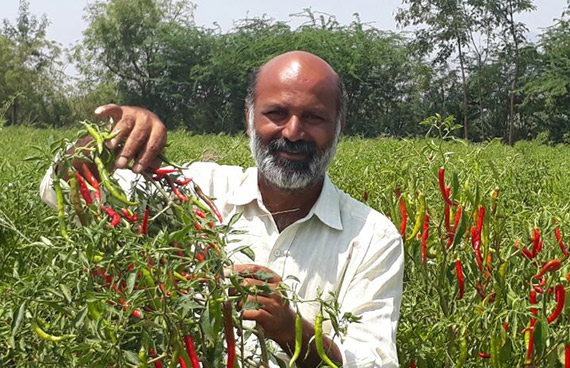Cashing in on Organic Cultivation
My Story
My forefathers were all farmers. I only studied up to the 7th standard. As I was keen on farming, I decided to farm our five-acres of land in Nellore district. It wasn’t smooth sailing though. I could use only upto two acres for cultivation as the rest of the land was rendered pretty much useless because of the high use of fertilizers and pesticides over the years, to boost crop yields.
In 2014, SST adopted the village. The team found that I wasn’t using all of my land. With the help of the local horticultural department, they conducted a demonstration on the benefits of Panchakavya, mulching sheets, crop rotation and other organic methods of boosting soil fertility. They also conducted soil tests.
I became a convert to organic methods of farming and began growing other crops, including vegetables, to improve soil fertility.
On SST’s suggestion, I switched from paddy to Chilli. As a result, yields have improved. I used to earn a little over a lakh of rupees annually from two acres. That’s now gone up to Rs 3.80 lakhs.
My children now study in a private school. My wife is part of a self-help group and helps the family save money. In February, I paid off the Rs. 15,000 bank loan I had taken for installing drip irrigation and to buy other inputs to do cultivation. SST arranged this loan through a bank and by helping us form a farmers’ group.
Today, I have the satisfaction of being seen as a model farmer by all in my village of Mannegunta. It gives me great satisfaction to get other farmers to use technologies that help boost crop yields.
I am happy that I have been able to be part of SST’s effort in achieving this.
The SST Way
Community Development Officer Sivajyothi who worked with Doraiswamy
We saw Doraswamy at a meeting SST organised with the Departments of Horticulture and the Irrigation. He wasn’t one to be convinced easily. He told the gathered experts that as his paddy crop didn’t fetch a good price, he couldn’t hope for much better from a vegetable crop.
When the meeting got over, we met him. We regularly kept in touch and later got him to agree for a soil test. The Village Development Facilitator got the test done so that based on quality of soil he could plant the right crop. I went to Doraswamy taking along an agronomist and we convinced him to start by planting Chilli and Brinjal.
We also took Doraswamy to a farm one kilometer away in a nearby village to show the results achieved by another farmer through the use of Panchakavya. The farmer, who grew citrus crops, told him about the higher yields he got through the use of low cost organic manure. Through our regular interaction, Doraswamy came to know that TVS and SST had the capability and expertise to guide people in the area of agriculture.
Doraswamy began by planting chilli on 50 cents of land. He was further motivated by the 50 percent subsidy offered by the government for mulching sheets that cost Rs. 15,000. We spoke to the bank manager and arranged the loan. With the help of drip irrigation, he is now cultivating on two acres of land. While his yield earlier was 68 kilograms from two crops, he now gets 80 kgs from a single crop. He plans to plant Brinjal on 50 cents of land before the monsoons begin.
Doraswamy is more than a model farmer. A few days back he opened a shop attached to his house that sells rice, pulses, cooking oil, soaps and other provisions. From a skeptic he has gone from strength to strength and prospered.
Our Takeaways
The way one approaches and makes the prospective beneficiary comfortable is important. They must also feel we know something that they can benefit from.
Being in constant touch and follow ups are key to earning trust and getting people involved.
Our own motivation is very important as it can be infectious and convince people that we genuinely care about their welfare.
